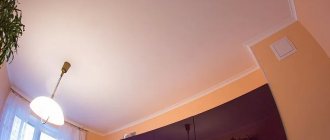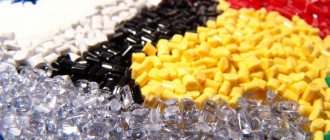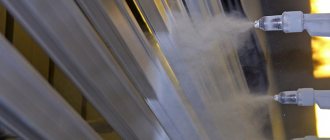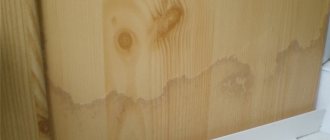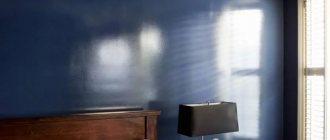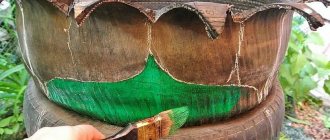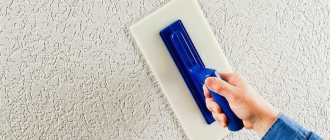Fiberglass wallpaper is a universal material for finishing walls and ceilings of any room. Previously, they were considered an office option, but the growing variety of textures, patterns and painting techniques have made it possible to use them in the design of living rooms.
The main advantage of the material is the ability to be repeatedly painted in different shades. To ensure that the properties of glass wallpaper are not lost, it is necessary to select high-quality paint and apply it according to technology.
Characteristics of glass wallpaper as a finishing material
Fiberglass wallpaper is made from special glass. It is melted, drawn into threads, woven and pressed. The result is a strong and durable material that differs from many other types of wallpaper in the following properties:
- Low fire hazard class. Does not ignite or burn.
- Antistatic effect. There is less dust settling on it.
- Air permeability. This property prevents the formation of mold and mildew on the surface of the plaster.
- Environmental safety. The fabric is made from natural materials without harmful chemical additives.
- Ability to hide minor defects. However, the wall must be leveled, since the thickness of the sheets will not be able to cover large differences in the plane.
- Additional surface reinforcement. Prevents the appearance of cracks and protects against external mechanical damage.
- Reduced paint consumption. The composition is applied in a thin, even layer, exactly as indicated on the package.
Due to the possibility of repeated staining, glass wallpaper can last more than 30 years. They are not afraid of moisture, are not attractive to fungus and mold, and do not absorb odors. Glass wallpaper is suitable for all rooms, even kitchens and bathrooms with high humidity.
Note! Fiberglass and fiberglass (painting canvas) are different types of materials. The first ones have a textured pattern and are intended for finishing. The latter are used to level the surface for puttying and painting; they do not have decorative qualities.
Typically, the color of glass wallpaper is gray-white. Any shade can be applied well to it. Whether to paint them or not depends on the design of the room. If you are satisfied with the original color, you don’t have to cover them with coloring compounds. But in this case, there is a possibility of wear at the ends of the strips and partial unraveling of the fabric. Therefore, professionals consider this stage mandatory. In addition, the paint holds the fibers together and does not allow them to separate.
The most common relief designs that are applied to glass wallpaper are: herringbone, matting, diagonal, diamond. There are also more rare ones - floral prints, ornaments, geometric shapes.
Painting and gluing glass wallpaper
Basic information
Fiberglass wallpaper is one of the most practical finishing materials for both industrial and residential premises. A huge variety of textures and woven patterns offered by manufacturers, as well as modern technology and excellent technical characteristics of the material, provide great opportunities for both interior design in traditional, classic styles, and for bold design experiments.
Photo: if everything is done correctly, the result will please you
No less, or even more important, than texture is color. It is he who sets the tone for the interior. Let's recall the basic principles of how to choose colors:
- Light colors visually enlarge the room, while dark colors make it smaller.
- Pleasant natural shades calm and help you relax, bright and sharp shades excite.
- It is good to decorate different functional areas in the room with different colors, while observing a certain unified principle for the entire interior.
How best to glue
Before gluing glass wallpaper for painting, it is necessary to take into account some features.
- Be careful and make sure where the front and back sides are before you start gluing. The fact is that, despite the fact that at first glance they are similar, in fact they are different. As a rule, the manufacturer marks both sides, or at least one of them.
- As for the choice of glue, it is necessary to use a special glue designed for gluing heavy types of wallpaper.
- Be sure to wear gloves before cutting as contact with the material may cause irritation to unprotected skin.
- They must be glued end-to-end, and the working surface must first be primed.
Glass wallpaper must be glued end-to-end
Attention! Before painting fiberglass wallpaper, it is also recommended to prime it! The primer is made using the same adhesive solution, only diluted with water. It is necessary to reduce paint consumption, since untreated surfaces have an increased ability to absorb.
After you have completed all of the above steps, you can proceed to the process of painting the wallpaper.
Painting rules
When purchasing, you have different options. You can immediately choose glass wallpaper for painting in a suitable color, or you can buy colorless ones and paint them in the desired color. However, even if you bought colored ones, after a while you will probably want changes in the interior - and then nothing will stop you from painting them in any other color, because glass wallpaper can be repainted repeatedly - the greater the depth of the texture, the more layers of paint can be applied before than it will finally smooth out.
Please note that it is advisable to pre-treat the surfaces with a primer.
To make your walls delight you with their beautiful appearance, you should follow a few simple rules:
- Before gluing, it is better to make sure that the wall (and in some cases, the ceiling) on which you are gluing the wallpaper should be level. Before priming the surface, it is necessary to prepare it perfectly. The fact is that glass wallpaper will perfectly mask minor wall defects - small cracks, roughness, etc., but there should not be large cracks or unevenness. Perhaps, after wallpapering, they will not immediately make themselves felt, but after painting, the “bubbles” will certainly become noticeable.
- Allow the wallpaper to dry completely before painting. At the same time, just as when gluing ordinary wallpaper, drafts should not be allowed into the room. Drying time is from twelve hours to a day. It is usually indicated on the glue package. Then you can safely paint.
- Very often, when applying the first layer, the paint consumption turns out to be more than indicated on the container. To save paint, first prime the wallpaper with wallpaper glue diluted according to the instructions on the container and let it dry. During subsequent painting, the paint consumption will not be more than usual.
- As when painting any porous surfaces, in their reviews and recommendations, experts recommend applying the paint as follows: the first layer is applied with vertical strokes, the second with horizontal strokes, or vice versa. You can also apply paint using a sprayer.
- Before applying the second coat, you should wait until the paint is completely dry, which requires at least 12 hours.
- Try to apply paint only in the required quantities. An excessively thick layer of paint helps smooth out the texture more quickly.
If you have the tools and basic skills, it’s quite possible to do all the work yourself
Like other wall coverings, glass wallpaper makes it possible to use combinations of two or more colors in the interior, and here the border of two colors does not necessarily have to be a straight line.
If this does not contradict the concept suggested by the texture, you can paint drawings - bright, or, conversely, in soft pastel colors, depending on your tastes and the purpose of the room. This is a job that requires great precision and care. It is better to apply the paint using a stencil, or entrust it to a specialist.
What quality paint should I choose for fiberglass wallpaper?
This depends on both the design goals and the purpose of the room. For design purposes, you can choose matte or glossy paint. The matte surface looks softer and more voluminous. Glass wallpaper coated with matte paint can be indistinguishable in appearance from ordinary fabrics. Glossy paint will emphasize the relief, the surface will seem harder, more “technical”.
Photo: a textured surface like matting or cobwebs looks especially attractive
As for the types of patterns on the surface, the most common are the following patterns:
What to paint with?
Depending on the purpose of the room, we choose less or more durable paint. Which ones are better? For a bathroom where there is high humidity, for a kitchen or hallway where there is a risk of staining the wall, you should choose paints that are most resistant to abrasion.
Pay attention to the product characteristics indicated on the packaging. The painting of glass wallpaper itself can be carried out using stencil or squeegee technology.
To paint wallpaper, different types of paint are used - acrylic, polyurethane, latex, water-emulsion and water-dispersion. The main thing is to make sure when purchasing that this paint is suitable for fiberglass wallpaper.
How to paint fiberglass wallpaper, video instructions:
Choosing paint for glass wallpaper
Not all types of interior paints are suitable for painting glass wallpaper. Firstly, it is necessary to preserve the properties of canvases, such as environmental friendliness, fire safety and breathability. Secondly, glass wallpaper is an expensive material; if you cover it with a cheap composition, then the money spent on purchasing rolls will be wasted.
Experts recommend using water-dispersion paints. They dry quickly, do not smell, do not emit toxic substances and are breathable. They penetrate well into the fibrous structure of fabrics and provide high-quality adhesion.
Special compositions are produced for textured and fiberglass wallpaper. Their consistency is more liquid, which allows them to better preserve the surface topography.
Water-dispersion paints differ in composition, namely, in the type of binder; accordingly, they are used for different types of premises.
Butadiene styrene (latex)
Latex paints are suitable for the bathroom and rooms facing the north side of the house. They are moisture resistant, so they can be washed repeatedly. The only limitation in their use is well-lit rooms. When exposed to ultraviolet radiation, the coating acquires a yellowish tint.
Acrylate
A universal option for any premises. The composition is easily tinted. Resistant to ultraviolet radiation and high humidity. Dries quickly. This is the optimal solution for painting glass wallpaper.
Polyvinyl acetate
Suitable only for dry rooms: bedroom, children's room, living room. They do not tolerate moisture, so it is not recommended to wash them. This option is used when it is necessary to reduce repair costs, since the cost of polyvinyl acetate paints is lower than acrylate and latex paints.
Proven and popular paint manufacturers
When choosing paint, it is important to pay attention to the manufacturer, since it is recommended to choose a well-known company that has earned its authority over a long time. This will give you more confidence in the quality of the chosen product.
The most famous paint manufacturers include:
- Tikkurila, whose products are characterized by high quality, the ability to dry quickly and have low consumption.
- Mattlatex is a latex paint that is characterized by resistance to mechanical damage. Used for interior decoration.
- Caparol is characterized by environmental friendliness, allowing the material to be used for finishing children's rooms.
When choosing paint for glass wallpaper, you should give preference only to the best products from trusted manufacturers . Only in this way will the treated surface have a pleasant appearance and last a long time.
How to paint glass wallpaper (1 video)
Selecting a shade
What color to paint glass wallpaper is determined mainly by personal preferences. Since technical standards provide for any shades. But there are some rules, they are dictated by the practical experience of builders:
- For light and translucent shades, it is necessary to carefully prepare the base even before wallpapering. The surface should have a uniform color, without spots or streaks.
- For the first coloring, you should not choose a bright or dark shade. If you get tired of it, painting it lighter will be problematic.
- Colors can and should be combined so that the walls do not look monolithic and too formal.
For the rest, you should be guided by the design of the room, the degree of its illumination, the color of the furniture and the functional purpose of the room.
Advice! You can buy colored paint or white and paint it yourself.
Staining with azure
For this method, two colors of paint are used. One will be calm shades, and the second will be catchy. Decorations in the form of flakes are also used. This method is used to combine colors.
When the painted area with the main color is dry, you need to use a flat brush and use it to apply the glaze. Movements should be short and the direction should be transverse. After 20 minutes, the surface is smoothed with a special rubber-based spatula so that the flakes are evenly distributed over the wall. For more information about the use of azure, watch this video:
To create a more saturated color, apply two layers of glaze.
Unusual ways of coloring and combining shades
Monochrome painting is not always appropriate in residential areas. You can create an atmosphere of comfort, change the proportions of space and zone a room by using different paint application techniques. Simple types can be completed independently; more complex ones require skill and experience - they are best entrusted to specialists.
Painting glass wallpaper with stencils
The use of stencils allows you to apply any design or pattern to the surface of glass wallpaper. You can purchase a ready-made stencil at construction centers or make an outline on the wall using masking tape.
Performance:
- Painting wallpaper in the main color. When using stencils, it is better to make the walls plain.
- Marking the drawing with masking tape.
- Painting with a roller (for large designs) or a foam sponge (for working out small details).
It is necessary to apply the design using a stencil after the base color has dried. Using this technique, you can decorate boring wallpaper at any time after painting.
The use of borders for painting walls
Borders are ready-made decorated strips. They can be made of fiberglass or any other material. With their help, they zone the room and adjust the proportions.
The horizontal arrangement of borders visually lowers a ceiling that is too high. Vertical, on the contrary, lifts. The shades of the areas between the dividing stripes can be combined.
Execution steps:
- Surface marking. Determining the areas where the curbs will be located. The gap between the wallpaper sheets should be slightly less than the width of the dividing strips.
- Coloring glass wallpaper. This stage is performed strictly before gluing the borders.
- Gluing borders after the paint has dried.
Important! Borders are not glued to the embossed surface of glass wallpaper. Only on a bare wall.
Application of glaze
Azure is a special composition that allows you to create a light, heterogeneous coating against a background of bright color, slightly muting the main shade. It is applied to the entire surface or to sections, forming a large pattern, without clear lines.
Coloring stages:
- Application of the main color. It is worth choosing a bright one so that the effect is more pronounced.
- Application of decorative glaze. For this purpose, use a wide flat brush. Movements should be jerky and multidirectional.
- Composition distribution. 10–20 minutes after application, the mixture is leveled with a rubber spatula.
The shade of the azure should be different from the main color. It is possible to apply a second layer of the composition if the effect is not bright enough.
Squeegee staining
For this technique, a special glaze coating (water-based decorative varnish) is used. It is translucent and takes longer to dry than water-based paints. This method allows you to create an unusual effect - the surface relief becomes more pronounced and voluminous.
Stages of work:
- The walls are painted in the main color. It is best to choose a rich, bright shade.
- After drying the first layer, a glazing composition is applied.
- Immediately wipe it with a slightly damp sponge or smooth it with a rubber spatula to remove paint particles on the convex parts of the relief.
Thus, the glaze composition remains only in the recesses, and the main color appears on the protruding parts.
Walls
0 votes
+
Vote for!
—
Vote against!
The modern market of finishing materials constantly amazes consumers with the variety of products presented, constantly expanding its range. Often, faced with the abundance on the market, craftsmen believe that repairs are not such a difficult task and decide to carry them out independently. And this applies not only to repairing minor defects and replacing flooring, but also to developing the final design appearance of the home. When carrying out modern renovations in an apartment, you must be aware that finishing work is one of the most important stages of a complex and multifaceted process, since it is at this stage that the final design appearance of the room and its stylistic concept are formed. In order to meet generally accepted design standards, the walls must be beautiful and well-groomed, and therefore, craftsmen attach special importance to their decoration, facing at this stage certain difficulties due to the variety of materials presented. However, most consumers remain faithful to traditional wallpaper, which now, like other materials, is presented in a huge assortment. But there are also those who are ruled not only by a conservative principle, but also by the desire to keep up with the times, taking a step towards innovative technologies. And, fortunately, there are many of them. This category of consumers prefers modern finishing materials, one of which is fiberglass wallpaper, which is an original and practical roll material. Using them, you can not only give the walls a well-groomed look, but also, if necessary, change their color. But here, too, there are some nuances, and therefore, we suggest you familiarize yourself with the features of choosing paint for painting glass wallpaper and the technology for its application.
Content
- Fiberglass wallpaper: general information
- The main advantages of glass wallpaper
- How to paint glass wallpaper for painting: choice of paints and varnishes
- Paint for painting glass wallpaper: popular manufacturers
- Painting glass wallpaper: choosing a color scheme
- How to paint glass wallpaper: preparatory activities
- Options for painting glass wallpaper: brief description
Fiberglass wallpaper: general information
Fiberglass wallpaper is a particularly durable and resistant decorative coating with high aesthetic characteristics. From the name it is clear that this material is unique, and even the name sometimes raises concerns among beginners regarding its production technology and decorative characteristics. To produce this material, natural raw materials are used, which makes fiberglass wallpaper an environmentally friendly material. Despite the fact that the name “fiberglass wallpaper” appeared on the market quite recently, this material is not as new as it might seem at first.
Western craftsmen first became acquainted with glass wallpaper back in the early 60s of the last century and, due to the fact that they have unique characteristics, they appreciated them. Having first appeared on the domestic market, they were used for finishing offices and public premises, and only after some time they began to be used as a finishing material for residential premises. For the manufacture of glass wallpaper, fiberglass is used, obtained from special glass briquettes, which, after heating, are drawn into threads. From these, woven fabric is produced, which is subsequently impregnated with a specialized composition. If you subsequently plan to change the color of the wall covering, glass wallpaper will be the best choice for you.
The main advantages of glass wallpaper
- Fiberglass wallpaper is a wear-resistant and durable material made from glass threads, the production of which is based on natural minerals. High-quality fiberglass fabric, resistant to tearing, thanks to its unique structure and optimal thickness, will withstand scratches from animals and contact with strollers and bicycles;
- Due to the fact that natural components are used for the production of glass wallpaper, they are an environmentally friendly finishing material suitable for finishing residential premises, including children's rooms;
- Fireproof material, not prone to fire. However, if it does occur, the glass wallpaper will not release toxic components during the combustion process;
- They are characterized by increased antistatic properties, and therefore are less susceptible to household pollution. If this does happen, you can simply wipe them with a damp cloth, either with or without the use of chemical cleaning agents;
- Due to the fact that fiberglass freely allows air and moisture to pass through, walls covered with glass wallpaper are not susceptible to mold and mildew;
- Despite the fact that glass wallpaper is not the cheapest material, by giving it preference, you can significantly save on repairs. This is due to the fact that the glass wallpaper contains reinforcing material; the surface to be finished does not require preliminary putty. In this regard, you will not need specialized screeds and mixtures;
- By choosing this material for decorating the walls of a living space and gluing glass wallpaper for painting, you will see new, previously missing notes of originality and originality in the interior. The chic and rich interior of the room, the walls of which are covered with glass wallpaper, will amaze even the most fastidious designer;
- This material is presented in a wide range, and even the most demanding buyer will be able to choose wallpaper of the required color and texture. The consumer is invited to pay attention to the variety of smooth and embossed glass wallpaper, the dense texture of which will make it possible to successfully disguise minor wall defects. To change the color of walls covered with glass wallpaper, you do not need to remove them and glue new ones. It will be enough to paint the glass wallpaper with your own hands, the technique of which will be discussed below.
Important! If you are planning to paint glass wallpaper soon, choose a fiberglass fabric with a deep relief pattern, which will retain its unique texture even after several paintings. When purchasing glass wallpaper, pay attention to the neatness of the weaving, as this indicates the quality of the material.
Painting glass wallpaper photo
How to paint glass wallpaper for painting: choice of paints and varnishes
Often craftsmen are faced with the question of the need to paint glass wallpaper. They rightfully ask the question: “Is it always necessary to paint fiberglass wallpaper, and is it as necessary as manufacturers of fiberglass fabrics position it?” In this case, it all depends on your taste preferences. If the color of the glass wallpaper fits perfectly into the overall color concept of the interior, we can safely say that the glass wallpaper does not need additional painting. However, in most cases, the manufacturer produces glass wallpaper specifically for painting, and therefore they are characterized by an inexpressive grayish-white color with low aesthetic qualities. Therefore, glass wallpaper is painted not in order to increase its functional characteristics, but only for aesthetic reasons. If you have made a choice in favor of painting glass wallpaper, it's time to decide on the paint for painting glass wallpaper. It would seem that everything is very simple, and all you need to do is go to a paint and varnish store and consult with a salesperson who will suggest the right solution. However, there are also pitfalls here, which can only be circumvented by carefully understanding this issue. So, how to paint glass wallpaper before painting?
Criteria for choosing paint for painting glass wallpaper:
The technology for painting glass wallpaper does not have any striking distinctive features that require separate consideration, and is similar to painting any other finishing materials. The only fundamental point that distinguishes painting glass wallpaper from painting other materials and is worthy of detailed consideration is the choice of a suitable paint and varnish material. Experts are confident and unanimously affirm that the best option in this case is to use water-dispersed compositions that meet all the criteria for paint for painting glass wallpaper. The main ones are the following:
- Minimum drying time;
- No pungent odor;
- Rapid penetration into the surface structure.
- Lack of toxic components.
Water-dispersion paints and varnishes consist of aqueous dispersions of some synthetic polymer and, after the water evaporates, they form a protective film on the surface of the fiberglass fabric, which is formed as a result of the bonding of synthetic polymer particles. In this regard, in the composition of these paints, not a solvent, but water is used as a diluent.
All water-dispersed compositions are conventionally divided into three main categories:
- Butadione-styrene dispersions have increased moisture resistance, but are characterized by a significant drawback that limits their use. It involves yellowing of the surface of painted glass wallpaper, which occurs under the influence of ultraviolet radiation. In this regard, butadione-styrene compounds are used in rooms that are characterized by a northern location and the absence of excess light;
- Polyvinyl acetate compositions are relatively low cost compared to other types of water-dispersion paints, which is due to their limited use. In particular, due to low water resistance, polyvinyl acetate paints can only be used in dry rooms;
- The most universal option for painting glass wallpaper is acrylic compositions , which have high moisture resistance and resistance to ultraviolet radiation. They are the ones most often used for painting glass wallpaper, due to their rapid drying and the ability to wash the surface after painting.
Important! If your room requires maximum passive fire protection, paint the glass wallpaper with fire-resistant acrylic paint. Metal communications also need to be treated with fire retardant compounds, for which fire retardant compounds for metal are best suited.
Latex and acrylate compositions are also suitable for painting glass wallpaper - in a word, in the process of choosing paint, you must take into account the desired result. In addition, when choosing paint, you need to pay attention to whether it is washable, which will significantly simplify further cleaning of the coating.
Paint for painting glass wallpaper: popular manufacturers
The most common paints and varnishes for painting glass wallpaper, which have received consumer recognition, are:
- Tikkurila Harmony is a high-quality paint and varnish material characterized by fast drying and low consumption. It is characterized by the absence of odor, and therefore is suitable for use in the bedroom or living room, as well as in the children's room. The manufacturer offers paint in matte colors, which contributes to the formation of a velvety surface. Grateful buyers of Tikurilla Garmonia paint leave only the most positive reviews about it, which is due not only to the aesthetic appearance of the material, but also to its affordable cost;
- Tikkurila Euro 2 is a matte paint made from acrylic copolymer with the addition of latex. Most often used only in dry rooms.
- Mattlatex Dufa is a latex paint in matte shades, characterized by high durability and cost-effectiveness.
Painting glass wallpaper: choosing a color scheme
When choosing a color scheme for painting glass wallpaper, rely on your own opinion and taste preferences. But, despite this, designers give their recommendations in this matter, the main ones of which will be discussed below.
- When painting glass wallpaper, experts do not recommend using bright and catchy colors, as they will soon begin to get boring and will cause nothing but irritation. In this regard, they will again need to be repainted in calmer colors;
- For owners who are supporters of bold design solutions, experts recommend using bright curly inserts against a background of calm pastel shades. The implementation of this design idea will not only diversify the interior of the room, but also visually expand it;
- When choosing furniture, it is important to take into account its compatibility with the color and shape of the pattern on the glass wallpaper, as well as the general stylistic concept of the interior as a whole;
- When applying a stencil pattern to glass wallpaper, you also need to follow the advice of experts. If you are painting and decorating glass wallpaper in small rooms, choose small-sized images, which will visually expand the room. If in this case you give preference to large drawings, they will help to visually reduce the volume of the room.
How to paint glass wallpaper: preparatory activities
Due to the fact that painting glass wallpaper is a fairly simple procedure, even an inexperienced master can cope with it. As mentioned earlier, it is recommended to paint glass wallpaper with water-based paint, therefore, having prepared the necessary paint and varnish composition, you can begin to work.
Important! Before starting painting, it is necessary to apply a primer to the surface of the glass wallpaper, which will help increase the adhesive characteristics of the paint. To apply paint as evenly as possible to the surface of the glass wallpaper, experts recommend using a roller.
The question regarding the need to first apply a primer to the surface of glass wallpaper is of interest to many specialists. In answer to this, it should be noted that applying a primer is a mandatory and extremely important stage in painting glass wallpaper, since it significantly improves the painting effect, making the texture of glass wallpaper brighter and of higher quality.
Important! The choice of primer depends only on the individual preferences of the master, however, there is a more economical option that involves the use of glue remaining after gluing the glass wallpaper. The quality of such an improvised primer is in no way inferior to the characteristics of a traditional primer and in some cases even exceeds them.
To apply the primer, it is necessary to use a roller, which promotes its uniform distribution over the surface of the glass wallpaper and increases the adhesive characteristics of the paint, which is applied to the surface of the glass wallpaper after the primer composition has completely dried.
Options for painting glass wallpaper: brief description
As mentioned earlier, when painting glass wallpaper, it is best to use a roller or spray bottle, which promotes the most even distribution of the composition. Painting glass wallpaper must be done in two layers, applying the second layer 12-14 hours after applying the first. There are several options for painting glass wallpaper:
- Painting using borders;
- Applying paint using stencils;
- Squeegee staining;
- Painting using azure.
Painting using borders is one of the options for painting glass wallpaper, allowing you to enliven the interior of any room from the living room to the bedroom. Having chosen to paint glass wallpaper using stencils, you can go in two ways:
- Use fiberglass-based wallpaper of the same texture both above and below the border;
- Create a more interesting textured solution by choosing wallpaper of different textures in relation to the border.
After you have glued the glass wallpaper for painting, you do not need to wait for it to dry completely - start making the border. To do this, mark and cut out a strip on the wall, the width of which corresponds to the size of the border. Next, the upper and lower sections of the wall in relation to the border must be painted in two layers (you can use related or even contrasting shades), with an interval of 10-12 hours between application of layers. After the paint has dried, a decorative border is glued into the free space.
Painting glass wallpaper using stencils involves creating some kind of geometric pattern or design. To do this, you need to select a pattern or ornament, the structure of which would prefer to have rectilinear structures, and transfer it to the wall using masking tape. To do this, a stencil is placed on the surface of previously painted wallpaper, displaying the exact contours of the design, after which, in accordance with the markings, adhesive tape is pasted, on top of which paint of the background color is applied so that it does not flow under the adhesive tape. After complete drying, the wallpaper is painted in the desired color with the selected pattern. As soon as the surface is completely dry, the tape is removed from the surface of the wallpaper. You can decorate the finished drawing with additional details or use another stencil. In this case, you can use any specialized paint to paint glass wallpaper.
Painting glass wallpaper with azure involves using a paint combination of a calm and catchy base color with white or decorative flakes of decorative materials. This method helps to achieve a variety of color combinations. After the base layer of paint has dried, using a flat brush, apply the glaze to the surface of the glass wallpaper using transverse and short strokes. After 15-20 minutes, smooth the surface with a rubber spatula, distributing the flakes evenly over the surface. If you want to make the color more saturated, apply a double layer of glaze and the elegant and presentable result will not take long to arrive.
Squeegee painting of glass wallpaper is a simple, but at the same time effective painting technique that allows you to achieve the original fabric texture of glass wallpaper. According to experts, brightly saturated colors should be used as the main layer of paint. After the base layer has dried, a glaze coating of a similar tone is applied to the surface, which can be a translucent water-based decorative varnish or a coating with a metallic effect.
Without waiting for the glaze coating to dry completely, remove the top layer and excess paint material with a damp sponge, keeping it only in the textured recesses of the glass wallpaper. Painting glass wallpaper using the squeegee technique can only be done using a special plastic or rubber spatula.
Painting glass wallpaper video
Technology of painting glass wallpaper in the main color
When painting glass wallpaper, you must adhere to the general rules for carrying out repair work. Close windows and doors to the room, protect the floor and furniture from paint splashes. Painting should be done at room temperature - 18-22 degrees and humidity up to 40-50%. Under such conditions, the paint will dry gradually and evenly. You should not use heating devices to speed up the process, as this will dry some areas faster and others slower - this can lead to stains and streaks.
Surface preparation
Painting is carried out no earlier than 72 hours after gluing. The glue under the wallpaper must dry thoroughly before the next stage of processing is done.
The surface of the glass wallpaper must be primed - this improves adhesion to the paint layer, reduces the consumption of the finishing coating, smoothes out loose fibers and binds dust particles. For processing, you should use a special primer or a weakly concentrated solution of wallpaper glue. It is allowed to dry, then they begin to apply paint.
Tools
To apply paint, use a spray gun or a long-haired roller - they paint the relief best. For hard-to-reach areas: corners, junction lines with the floor and ceiling, you will need a narrow brush.
If the paint needs to be tinted before use, you should stock up on a construction mixer to thoroughly distribute the dye throughout the mass.
Application
Handling a spray gun requires experience and skill; non-professionals are better off using a roller. Staining is carried out according to the following scheme:
- Stir the paint before use.
- Pour a little into the cuvette.
- Dip the brush and remove excess paint from it.
- Paint corners and joint lines. It is important to ensure that the composition fills all the recesses on the glass wallpaper.
- Dip a roller into the paint and roll it along the top of the container so that the composition is distributed evenly throughout the coat.
- Paint the main part of the walls. Moving from the ceiling to the floor. A fresh strip should always overlap the previous one by a few millimeters. You will have to press lightly on the roller to paint the cavities.
It is best to start work from the corner, where the edge painted with a brush ends. During application, you should not take breaks, as a stripe will appear in the place where the process is stopped. Therefore, it is necessary to paint the entire room in one go.
Glass wallpaper is painted in two layers. The second is applied 12 hours after the first, according to similar instructions.
Painting with borders
Use wallpaper of a different texture as borders.
Using this method, you can enliven any room. If you use a stencil for these purposes, you can paint using two methods:
- Use glass wallpaper that is identical in texture both at the top and bottom of the curb for painting.
- Use wallpaper of different textures in relation to the border.
After pasting the wallpaper, you don’t have to wait for it to dry, but immediately start creating borders. The procedure looks like this:
- A strip is marked and cut out on the wall; it should be similar in width to the border.
- The top and bottom of the wall in relation to the curb are painted in two layers.
- When both layers are dry, decoration in the form of borders is glued to the free space.
Surface care after applying paint and repainting
Features of glass wallpaper care are determined by the type of paint applied. If it is latex or acrylic, then it can be washed using non-abrasive detergents. It is no longer possible to remove dirt from polyvinyl acetate paint. To increase the service life of latex-based compositions, direct sunlight into the room should be limited.
In case of severe contamination, fading or wear, the paint is renewed. You can repeat the procedure an unlimited number of times. But with each layer the relief of the glass wallpaper will be smoothed out. The optimal number of stains is 5.
Advice! Glass wallpaper with a pronounced relief can be painted more times.
Fiberglass wallpaper is a high-quality and durable coating for walls and ceilings. Their use for decoration allows you to change the design and color scheme of the room at any time, repeatedly and quickly.
Stencil painting
The stencil needs to be glued to tape.
This option is based on the use of stencils in the form of patterns and other geometric shapes. The master needs to select the desired pattern or design and transfer it to the wall. Masking tape is used for transfer.
Before performing the procedure, the wallpaper must be painted, after which a stencil is applied to it, and tape is applied along its contours. Next, the surface is painted and it is important to ensure that the paint does not get under the tape.
When everything is dry, you need to remove the tape and check the work. If there are irregularities in the lines, they are completed. You can also decorate the drawing with additional details.
To prevent the paint from flowing under the tape, you do not need to put a lot of paint on the brush or roller, then it will not flow down the wall and will not get under the stencil.
Color options
One of the most important advantages of glass wallpaper is the ability to paint it in any color. You can choose your color scheme from millions of colors, tones, shades. Since the paint is sold in white, you will need to tint it (make the desired color) and here you can go in two different ways:
- You can tint the paint yourself using a specially sold coloring pigment or concentrate. At the same time, you will not be able to have a strong variation in color, since for an accurate match you will have to dilute the paint cans with a precise amount of color. For example, for a 1-liter can of paint, 1 can of color, or for a 7-liter container, 4 tubes of color. The advantage of this method is that you will always know how to mix additional paint if there is not enough.
- The second option for tinting paint is computer-based, which is done directly in the store. When choosing this method, you are not limited in colors and can choose any one. Experts will tell you exactly how the paint will look on the wall, since after application it often becomes a tone lighter. However, you should save the settings of the device in order to be able to make more coloring composition of the desired color in the future, but, unfortunately, this is not always possible, especially when it comes to subtle shades.
Related article: Trend in interior design - fish scale tiles
Contrasting living room interior
You should choose a color for painting the walls based on your preferences, but you should definitely listen to the designers’ recommendations:
- For glass wallpaper, it is recommended to choose soft, discreet, calm colors. This color will be appropriate for all walls, it will not strain or put pressure, and later it can be easily changed to another by repainting it in 1-2 layers.
- For people who approach the interior creatively, who need a lively, contrasting design, we can suggest making bright inserts on the walls. Against the background of a calm general tone, they will look catchy and attract attention.
- Don't forget about your furniture, which should fit into the overall color concept of the room.
Using wallpaper stencils, you can add the necessary elements to the interior, while paint for glass wallpaper is also used for painting, but the color is different. If you have creative abilities, you can draw a picture on the wall. Try not to overdo it with the dimensions of the picture; for small rooms you should limit yourself to the appropriate images.
Painting walls by hand
Performance characteristics of fiberglass
A high-quality sheet has a density of 25-52 g/m2. Material with a density of 45-50 g/m2 is glued to the walls. Problem areas are eliminated. Canvas is often offered for sale in fifty-meter rolls, its width is 1 meter. But the length varies.
Ceilings are covered with material with a density of 25-40 g/m2. If the base is covered with plasterboard, then the working temperature for gluing fiberglass is 10-25 degrees above zero, humidity does not exceed 60%.
For gluing finishing materials, the following are purchased additionally:
- Glue . Fiberglass is endowed with greater absorbency compared to glass wallpaper, so the glue consumption is greater. For example, Glue for fiberglass wallpaper - Dry glue “Wellton” for painting fiberglass canvas 300 g, price 285 rubles, Russia.
- Putty , universal composition is recommended. UNIVERSAL PUTTY FOR EXTERNAL AND INTERIOR WORK, for 1 kg - 90 rubles, consumption - 500 g. per 1 m2. It is easy for a beginner to work with Vetonit compositions. These are dry mixtures, selected to suit the conditions in the room.
- Spatula and knife.
A fragile sheet glued to the surface turns into a reinforcing mesh and is not considered as a finishing material. It is painted several times.
General information
Like glass wallpaper, fiberglass is made of fiberglass threads. Its difference from wallpaper is that it is not woven on a machine, but is pressed using a method reminiscent of the paper-making process. The result is smooth and even sheets with a density in the range of 25-50 grams per square meter.
This material is used not only because it allows you to quickly prepare walls or ceilings for painting, but also for a number of other reasons:
- Water resistance;
- Resistance to chemical reagents;
- The material does not accumulate static electricity, so it does not attract dust;
- Prevents the occurrence of fungus and mold;
- The fabrics allow air and steam to pass through well.
In the photo - fiberglass
In other words, fiberglass has the same properties as glass wallpaper. The only thing is that it does not have a pronounced texture, but for that reason it can be repainted many times.
Types of water-dispersion paints
There are three groups of water-dispersed compositions:
- Butadiene-styrene dispersions. This type of paint is highly resistant to moisture. However, these paints and varnishes also have a significant drawback - instability to ultraviolet radiation. Over time, surfaces painted with styrene-butadiene dispersions fade greatly, so they try to use such paints in rooms with windows facing north.
- Polyvinyl acetate paint and varnish compositions. Paints of this type are distinguished by their low prices. Polyvinyl acetate is not characterized by high water resistance, so its scope of application is dry rooms.
- Acrylic compositions. This type of paint and varnish material is characterized by maximum water resistance. Acrylic also tolerates ultraviolet radiation well. Another advantage of acrylic is quick drying. Acrylic paints are considered the best choice for painting fiberglass wallpaper.
Note! If you need additional protection of the room from fire, you can purchase special fire-resistant acrylic paint.
What paint to paint glass wallpaper: washable latex and acrylic options
Using glass wallpaper in your interior is quite a smart step, especially if you choose high-quality wallpaper for painting. In previous articles, we have already talked about the properties of glass wallpaper, which distinguish them favorably from other similar finishing materials. In this article we will tell you how to paint glass wallpaper, because the finishing layer on the wall should be paint.
Good paint makes painting work enjoyable
